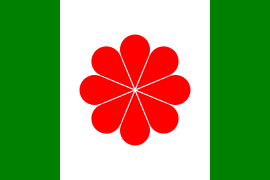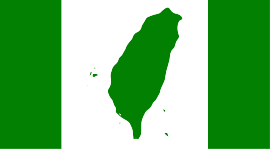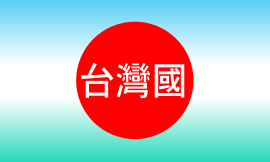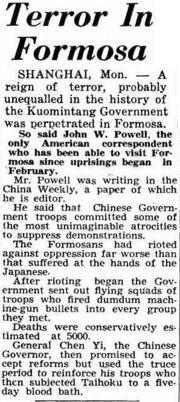حركة استقلال تايوان
| حركة استقلال تايوان |
|---|
 |
|
|
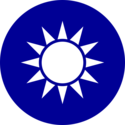 |
|---|
|
|
| حركة استقلال تايوان | |||||||||||||||||||||||||||
|---|---|---|---|---|---|---|---|---|---|---|---|---|---|---|---|---|---|---|---|---|---|---|---|---|---|---|---|
| الصينية التقليدية | 臺灣獨立運動 or 台灣獨立運動 | ||||||||||||||||||||||||||
| الصينية المبسطة | 台湾独立运动 | ||||||||||||||||||||||||||
| |||||||||||||||||||||||||||
| commonly abbreviated as | |||||||||||||||||||||||||||
| الصينية التقليدية | 臺獨 or 台獨 | ||||||||||||||||||||||||||
| الصينية المبسطة | 台独 | ||||||||||||||||||||||||||
| |||||||||||||||||||||||||||
حركة استقلال تايوان هي حركة سياسية to pursue formal independence of Taiwan.
Goals for independence have arisen from international law in relation to the 1952 Treaty of San Francisco.[1][2][3][4] Supporters contend that when Japan renounced all rights to the island of Taiwan and Penghu in 1952, it did not specify the successor state. Consequently, the sovereignty of the two territories should be determined by Taiwanese people through self-determination and referendums in Taiwan.
Taiwan independence is supported by the Pan-Green Coalition in Taiwan, but opposed by the Pan-Blue Coalition which seeks to retain the somewhat ambiguous status quo of the Republic of China (ROC) under the 1992 consensus, or gradually reunify with mainland China at some point.[5]
The use of independence for Taiwan can be ambiguous. If some supporters articulate that they agree to the independence of Taiwan, they may either be referring to the notion of formally creating an independent Republic of Taiwan, or to the notion that Taiwan has become synonymous with the current Republic of China from Resolution on Taiwan's Future and ROC-Taiwan is already independent (as reflected in the evolving concept from Four Noes and One Without to One Country on Each Side); both of these ideas run counter to the claims of the People's Republic of China. Some supporters advocate the exclusion of Kinmen and Matsu, which are still being controlled by Republic of China but are in fact part of the definition of mainland China.[6] Therefore, the differences between the opinions of different camps in support of and against independence can be very subtle.
من 1683 إلى 1894، كانت تايوان محكومة من امبراطورية تشينگ في الصين. وعقب الحرب الصينية اليابانية الأولى في 1895، تنازلت حكومة تشينگ عن تايوان للإمبراطورية اليابان عبر معاهدة شيمونوسكي. At the end of World War II in 1945, Taiwan was placed under the control of the ROC, which was widely recognized as China. Since the defeat and expulsion of the ruling كومنتانگ ROC government by the Communist Party of China from mainland China in 1949, the ROC government has controlled only Taiwan and its surrounding islands. It is a point of contention as to whether Taiwan has already achieved de facto independence under the Constitution of the Republic of China amended in 2005.
. . . . . . . . . . . . . . . . . . . . . . . . . . . . . . . . . . . . . . . . . . . . . . . . . . . . . . . . . . . . . . . . . . . . . . . . . . . . . . . . . . . . . . . . . . . . . . . . . . . . . . . . . . . . . . . . . . . . . . . . . . . . . . . . . . . . . . . . . . . . . . . . . . . . . . . . . . . . . . . . . . . . . . . .
تاريخ الحركة
Many supporters of independence for Taiwan view the تاريخ تايوان since the 17th century as a continuous struggle for independence and use it as an inspiration for the current political movement.[7]
According to this view, the people indigenous to Taiwan and those who have taken up residence there have been repeatedly occupied by groups including the Dutch, the Spanish, the Ming, Koxinga and the Ming loyalists, the Qing, the Japanese and finally the Chinese Nationalists led by the Kuomintang. From a pro-independence supporter's point of view, the movement for Taiwan independence began under Qing rule in the 1680s which led to a well known saying those days, "Every three years an uprising, every five years a rebellion". Taiwan Independence supporters compared Taiwan under Kuomintang rule to South Africa under apartheid.[8] The Taiwan independence movement under Japan was supported by Mao Zedong in the 1930s as a means of freeing Taiwan from Japanese rule.[9]
With the end of World War II in 1945, by issuing "General Order No. 1" to the Supreme Commander for the Allied Powers, the Allies agreed that the Republic of China Army under the Kuomintang would "temporarily occupy Taiwan, on behalf of the Allied forces."[10]
فترة الحكم العرفي
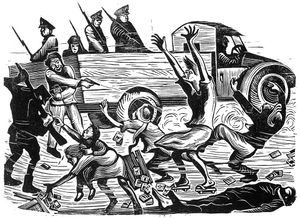
Modern-day political movement for Taiwan independence dates back to the Japanese colonial period but only became a viable political force within Taiwan in the 1990s. Taiwanese independence was advocated periodically during the Japanese colonial period, but was suppressed by the Japanese government. These efforts were the goal of the Taiwanese Communist Party of the late 1920s. Unlike current formulations, and in line with the thinking of the Comintern, such a state would have been a proletarian one. With the end of World War II in 1945, Japanese rule ended, but the subsequent autocratic rule of the ROC's كومنتانگ (KMT) later revived calls for local rule. However, it was a movement supported by the Chinese students who were born on the Island and not associated with KMT. It found its roots in the US and Japan. In the 1950s a Republic of Taiwan Provisional Government was set up in Japan. Thomas Liao was nominally the President. At one time it held quasi-official relations with the newly independent Indonesia. This was possible mainly through the connections between Sukarno and the Provisional Government's Southeast Asian liaison, Chen Chih-hsiung, who had assisted in Indonesia's local resistance movements against the Japanese rule.
After the Kuomintang began to rule the island, the focus of the movement was as a vehicle for discontent from the native Taiwanese against the rule of "mainlanders" (i.e. mainland Chinese-born people who fled to Taiwan with KMT in the late 1940s). The February 28 Incident in 1947 and the ensuing martial law which lasted until 1987 contributed to a so-called sense of White Terror on the island. In 1979, the Kaohsiung Incident, occurred as the movement for democracy and independence intensified.
معارضة الاستقلال
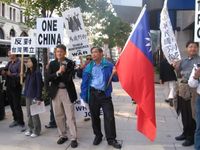
أبرز المؤيدين
- تشن شوي-بيان، رئيس جمهورية الصين (تايوان 2000–2008)
انظر أيضاً
- تاريخ تايوان
- Formosa Alliance
- Democratic Progressive Party
- اتحاد تضامن تايوان
- تايوَنة Taiwanization
- حركة الأدب التايواني
- الشعب التايواني
- Taiwanese nationalism
- Tangwai movement
- History of Taiwan under Japanese rule
- تاريخ جمهورية الصين
- الحرب الأهلية الصينية
- نظرية الأربع مراحل لجمهورية الصين
- العلاقات الخارجية لتايوان
- تايوان في الأمم المتحدة
- قانون علاقات تايوان
- Three Communiqués
- Taiwan Name Rectification Campaign
- إجماع تايوان
- الولاية الحادية والخمسون (أن تصبح الولاية رقم 51 في الولايات المتحدة)
الهامش
- ^ Tkacik, John. "Taiwan's "Unsettled" International Status: Preserving U.S. Options in the Pacific". The Heritage Foundation.
- ^ http://ir.lawnet.fordham.edu/cgi/viewcontent.cgi?article=1950&context=ilj
- ^ http://www.fpri.org/docs/media/201107.delisle.taiwan.pdf
- ^ http://digital.law.washington.edu/dspace-law/bitstream/handle/1773.1/748/11PacRimLPolyJ063.pdf
- ^ U.S.-Taiwan Defense Relations in the Bush Administration Archived 2006-03-16 at the Wayback Machine, The Heritage Foundation (noting the policy of President George W. Bush toward Taiwan's defense).
- ^ Department of External Affairs (1955). Current Notes on International Affairs. Vol. 26. Canberra: Department of External Affairs. p. 57.
In this area of tension and danger a distinction, I think, can validly be made between the position of Formosa and Pescadores, and the islands off the China coast now in Nationalist hands; the latter are indisputably part of the territory of China; the former, Formosa and the Pescadores, which were Japanese colonies for fifty years prior to 1945 and had had a checkered history before that are not.
{{cite book}}: CS1 maint: numeric names: authors list (link) - ^ Li, Thian-hok (April 15, 1956). "Our Historical Struggle for Liberty". Free Formosans' Formosa Newsletter. Free Formosans' Formosa. Archived from the original on September 28, 2007.
{{cite journal}}: Unknown parameter|deadurl=ignored (|url-status=suggested) (help) - ^ "台灣海外網". www.taiwanus.net.
- ^ Hsiao, Frank; Sullivan, Lawrence (1979). "The Chinese Communist Party and the Status of Taiwan, 1928-1943". Pacific Affairs. Pacific Affairs, Vol. 52, No. 3. 52 (3): 446–467. doi:10.2307/2757657. JSTOR 2757657.
- ^ "Methods of Acquiring Sovereignty: PRESCRIPTION". Related Topics: Sovereignty. Taiwan Documents Project.
للاستزادة
- Bush, R. & O'Hanlon, M. (2007). A War Like No Other: The Truth About China's Challenge to America. Wiley. ISBN 0-471-98677-1
- Bush, R. (2006). Untying the Knot: Making Peace in the Taiwan Strait. Brookings Institution Press. ISBN 0-8157-1290-1
- Carpenter, T. (2006). America's Coming War with China: A Collision Course over Taiwan. Palgrave Macmillan. ISBN 1-4039-6841-1
- Cole, B. (2006). Taiwan's Security: History and Prospects. Routledge. ISBN 0-415-36581-3
- Copper, J. (2006). Playing with Fire: The Looming War with China over Taiwan. Praeger Security International General Interest. ISBN 0-275-98888-0
- Federation of American Scientists et al. (2006). Chinese Nuclear Forces and U.S. Nuclear War Planning
- Gill, B. (2007). Rising Star: China's New Security Diplomacy. Brookings Institution Press. ISBN 0-8157-3146-9
- Manthorpe, Jonathan (2008). Forbidden Nation: a History of Taiwan. Palgrave MacMillan. ISBN 1-4039-6981-7
- Shirk, S. (2007). China: Fragile Superpower: How China's Internal Politics Could Derail Its Peaceful Rise. Oxford University Press. ISBN 0-19-530609-0
- Tsang, S. (2006). If China Attacks Taiwan: Military Strategy, Politics and Economics. Routledge. ISBN 0-415-40785-0
- Tucker, N.B. (2005). Dangerous Strait: the U.S.-Taiwan-China Crisis. Columbia University Press. ISBN 0-231-13564-5
وصلات خارجية
- تاريخ تايوان
- نعم لتايوان
- التاريخ الحقيقي لتايوان
- معاهدة سان فرانسسكو مقابل إعلان القاهرة
- تعداد ولغات تايوان
- خط زمني لتايوان
- تاريخ تايوان في رسوم كرتونية
- World United Formosans for Independence
- استفتاء تايوان يجب أن يسأل عن سيادة الولايات المتحدة
- أمريكا وتايوان، 1943-2004
- مشروع وثائق تايوان
- Formosan Association for Public Affairs





